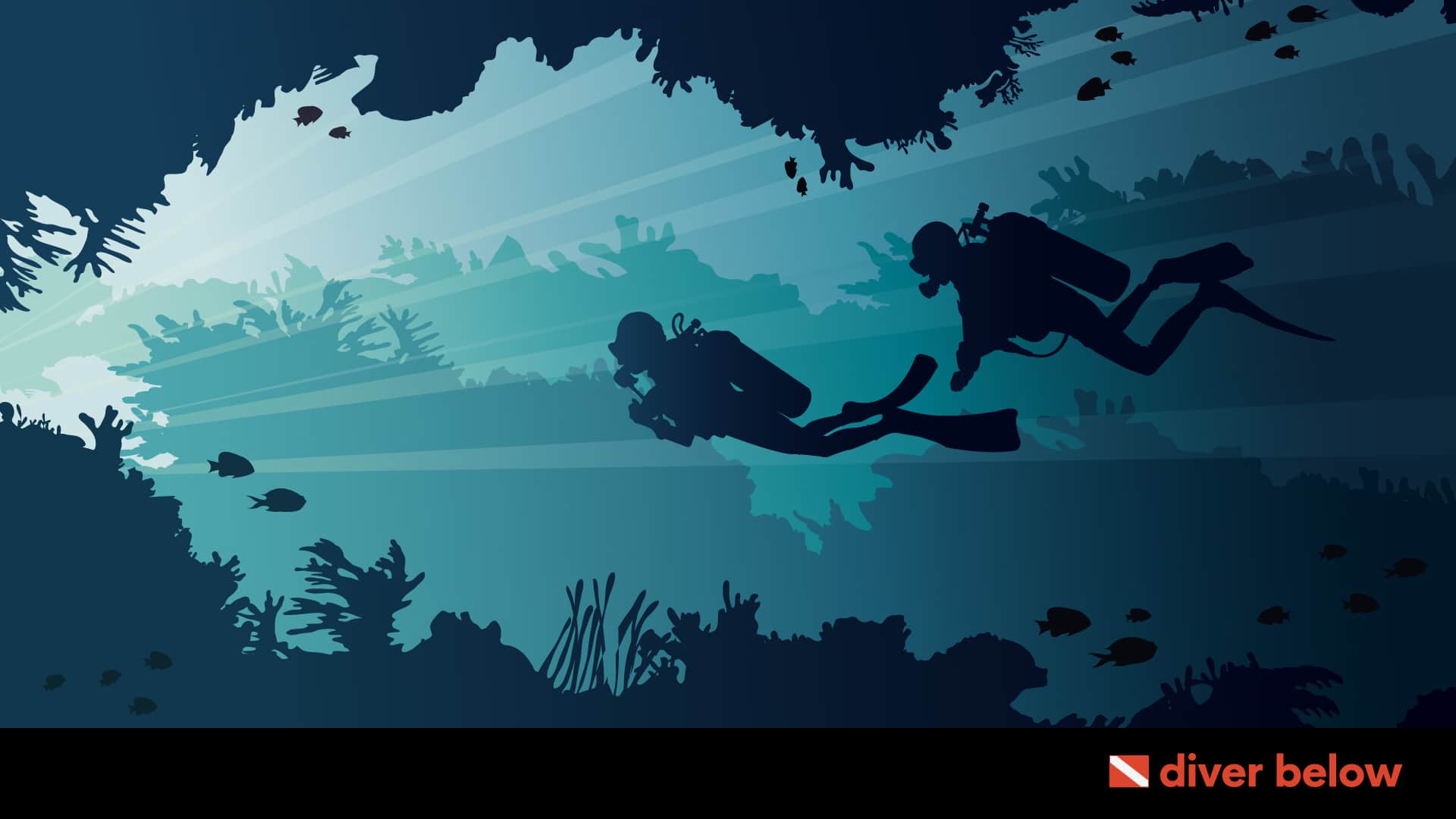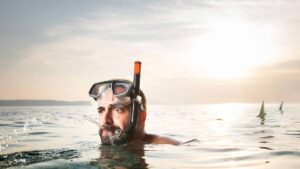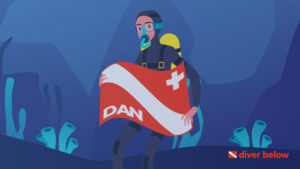There’s snorkeling, there’s scuba certifications like open-water scuba diving – and then there’s cave diving.
The beauty found in underwater environments all around the world isn’t limited to colorful coral reefs and an endless blue ocean.
There are spaces that are harder to reach and, therefore, require a certain kind of person to explore.
Cave divers take on numerous challenges and risks to go where few others have before.
This article will help you get a better understanding of what cave diving is, which certifications you’ll need, and what the best sites around the world are for cave diving.
Contents
What Is Cave Diving?
Cave diving is the underwater exploration in a space with an overhead ceiling environment without natural light.
A cave diver is highly specialized in technical diving and has gone through rigorous training.
Although many cave divers learn this skill for recreational purposes, cave diving is considered less of an extreme sport and more of a tool for scientific discovery and exploration.
If you ever meet a diver with a scientific scuba diving certification, they’ve likely looked into cave diving at some point in their career.

Why Would Someone Want To Go Cave Diving?
For those who enjoy testing their limits and challenging themselves, cave diving is a gratifying experience.
It can also help further scientific endeavors and aid in search and rescue operations.
If you’ve ever seen a photo from a cave diving expedition, the surreal underwater world alone might be enough to tempt you to learn.
Cave divers can experience parts of the world that few before them have encountered, which is part of the appeal.
Cave Diving vs. Cavern Diving
Although some divers use the terms ‘cave’ and ‘cavern’ interchangeably in conversation, these words have vastly different meanings in the scuba diving world.
As we’ve already covered, cave diving is an underwater exploration that occurs in a space without sunlight with an overhead environment.
Cave divers can penetrate areas with limited visibility and explore thousands of yards of overhead environments in a single dive with their highly specialized skill set.
Conversely, cavern diving is a more limited diving experience.
The National Speleological Society defines cavern diving as the area in front of a cave with direct sunlight.
A cavern will be no deeper than 70 feet, and it will be within 130 linear feet of the cave entrance.
Cavern divers remain close to the cave entrance, where sunlight allows for greater visibility underwater.
Although the mouth of a cave has overhead obstacles, divers are closer to open water.
Some divers further differentiate between these two types of diving based on their general purpose.
While cavern diving is considered more of an extreme sport to many, cave diving is a highly specialized form of diving that typically contributes to scientific exploration or search and rescue operations.
Types of Caves
Cave divers explore several different types of caves, each with its own unique characteristics, levels of complexity, and composition.
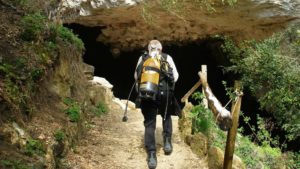
Lava Tubes
Caves that form from volcanic eruptions are called lava tubes or lava caves.
These caves are the second most common type of cave found in the world.
During a volcanic eruption, lava will flow through an environment much like a river.
As it does, the topmost layer of lava exposed to air will cool down and solidify into black rock basalt.
Lava will continue to flow beneath this layer until the volcanic eruption has ended or the lava flow has moved to a different location, which leaves a lava “tube” behind.
Lava tubes tend to be closer to the Earth’s surface, which means that this type of cave system is more likely to experience collapses and have a more significant number of cave entrances.
Lava tubes tend to be less complex than their solution cave counterparts.
Littoral Caves
Littoral caves, also known as sea caves, are formed along the coasts of oceans and large lakes.
These caves are formed by wave action against the rock, resulting in erosion over time.
As waves continue to break against the cliff, weak zones or faults in the rock give way and create large cavities that eventually become caves.
Faults in rock or sediment can stretch on for a long distance, depending on the cliff structure, which results in a cave system.
Coral Caves
Coral caves, which divers can find in coral reefs throughout the world, are some of the least explored caves.
They can be massive, which is part of the reason they are challenging to navigate.
Did You Know?
There are many types of coral in the ocean. This coral forms beautiful formations that are great for diving in and around.
Solution Caves
According to the National Park Service, solution caves are the most common type of cave system.
Due to the way they are formed, they also tend to be the most complex.
When groundwater seeps underground through various cracks or other surface openings, a solution cave can form.
However, due to the slow erosion process over time, it can take several geological epochs for solution caves to form, which can be hundreds of thousands of years.
Solution caves form most commonly in the limestone rock but can also be found in marble, gypsum, dolomite, chalk, or salt.
Solution caves often contain geological features like stalagmites and stalactites, which are mineral build-ups that form over time and usually take on conical shapes.
When Was Cave Diving Invented?
For hundreds of years, explorers braved the dark, damp depths of dry caves in search of other entrances, scientific discoveries, and for the simple desire to see what others have not seen before.
However, when explorers met with a submerged portion of a cave, their progress would come to a halt.
The need to access other dry portions of caves gave birth to the notion of cave diving, which became a more popular tool of exploration in the 1930s.
The first recorded cave dive occurred on July 14, 1935, in the Wookey Hole Caves in England by Graham Balcombe and Penelope Powell.
The pair descended into the submerged Fourth Chamber of the Wookey Hole Caves and discovered the Fifth, Sixth, and Seventh Chambers.
Is Cave Diving Dangerous?
Cave diving is an inherently risky endeavor, and all cave divers must accept these risks and prepare for them before going on a dive.
Why Cave Diving Is Dangerous
Conditions underwater can change in a moment, which adds a certain level of unpredictability to every dive.
Cave diving has a range of factors that divers need to be aware of.
Factors That Make Cave Diving Dangerous
In order to face any challenge that might come their way, cave divers train extensively and learn that remaining calm in challenging situations and teamwork can mean the difference between life and death.
After all, the last thing any cave diver wants is to deal with a panicked diver deep inside a cave.
Here are a few other hazards cave divers must prepare for before embarking on a dive.
1. Overhead Environment
The average scuba diver descends in open water, where no obstacles prevent a quick return to the surface.
Conversely, in a cave environment, it isn’t possible for divers to quickly return to the surface in case of an emergency.
Instead, divers must follow their guide-lines back through the cave until they find a safe place to surface.
2. Limited Air Supply
Being unable to return to the surface quickly means that all cave divers have a limited air supply while submerged.
A cave diver cannot simply surface for oxygen if an accident occurs a mile into the dive.
High-stress situations can also affect a diver’s air supply.
In the event of an emergency, a cave diver can panic, which may lead to heavier or quicker breathing.
The faster a diver breathes, the faster their tank of air supply depletes.
3. Loose Silt and Limited Visibility
Without natural sunlight illuminating their surroundings, cave divers must rely on dive lights.
But a flashlight can only be so helpful.
Crystal clear water can quickly become murky with the smallest of flutter kicks, which can disturb silt and sediment on the cave floor.
Lack of visibility can cause disorientation.
Cave divers also rely on a guide-line that helps them return to their starting point.
Common Reasons Why Cave Divers Die
Over 400 cave divers have died since the first cave dive in 1935.
While diving in an overhead environment, having limited air supply and having limited visibility can be contributing factors to why cave diving can result in death.
These are all consequences of a diver exceeding their personal limits when it comes to training and experience.
The most common cause of death among cave divers is asphyxiation due to drowning.
As previously stated, this can be the result of under-preparedness or exceeding one’s limits.
How To Start Cave Diving
Interested in becoming cave diving certified?
Follow these steps to make sure this is the right path for you.
1. Do Your Research
Before starting any new endeavor, it’s crucial to conduct proper research to gain an understanding of what you hope to achieve.
Knowledge is fundamental when it comes to cave diving.
Research can include watching videos of cave dives on Youtube to get a first-hand look at what challenges divers face, what environments they explore, and how they react under pressure.
2. Make Sure You Can Stomach the Risks
We’ve already dedicated an entire section of this article to the dangers of cave diving.
If that section gave you pause, it might be a good idea to explore the subject further.
Before you dive in, literally and metaphorically, you have to be comfortable with the risks associated with cave diving.
3. Get Properly Trained
Proper training and certification are crucial to becoming a cave diver.
We’ll discuss certifications in our next section, but make sure you choose a reputable place when it comes to training.
You’re more likely to find legitimate trainers in specific geographic locations, especially areas with access to the ocean.
Doing a simple Google search of cave diving training will give you several different places to start.
It comes down to determining which trainers you’re geographically closer to and what you can afford.
Cave diving courses are detail-oriented and focus heavily on the protocol.
4. Acquire the Proper Gear
We’ll cover what kind of gear you’ll need in another section of this article.
Before you get started down the path of becoming a cave diver, it’s essential to know if you can afford the specialized gear you’ll need.
Cave Diving Certifications
Because cave diving is a form of technical diving, you must train for and acquire certification before your first dive.
All forms of training for this technical certification start with mastering cavern diving.
PADI Cave Diving Certification
PADI, or the Professional Association of Diving Instructors, offers technical diving courses as forms of continued education for divers who already have a little bit of experience.
Here’s a list of PADI’s technical diving courses:
- Technical Diving: A short course that familiarizes divers with diving in a contained environment. Divers learn basic technical diving skills.
- Tec 40 (Part 1): This course consists of ten sessions split between three knowledge development classes, three application classes, and four training dives.
- Tec 45 (Part 2): This course allows divers to extend their depth and range and teaches students how to plan and succeed at repetitive decompression dives using a single decompression cylinder.
- Tec 50 (Part 3): This course allows students to extend their dive range and limit further. It teaches students how to extend and accelerate decompression stops using up to 2 gases.
SSI Cave Diving Certification
Scuba Schools International (SSI) offers a cave diving program that teaches divers the technical skills needed to complete deeper and longer confined dives.
The course requires a total of 18 hours of class/dive time.
SSI offers:
- Extended Range Cavern Diving Program: Students must first be certified in extended-range cavern diving before moving on to SSI’s cave diving program. This course teaches divers how to use cavern diving equipment, gas management, and how to work as part of a dive team.
- Cave Diving Program: This introductory course introduces students to cave diving equipment and procedures, dive safety, and diving with a buddy.
- Full Cave Diving Program: This advanced full cave diver course teaches complex underwater navigation skills in order to traverse extensive cave systems.
SDI/TDI/ERDI/PFI Cave Diving Certification
SDI/TDI/ERDI/PFI offers cave diving courses that build off cavern diving knowledge and certifications.
TDI offers:
- Intro to Cave Diving: Students learn gas management techniques, cave diving policies, diving safety, communication, swimming techniques, and more.
- Full Cave: Students learn how to operate cave diving equipment, physiology, how cave environments work, gain problem-solving skills, learn crisis management, and more.
NAUI Worldwide Cave Diving Certification
The National Association of Underwater Instructors (NAUI) offers several cave diving programs that range from introductory cavern diving to advanced technical cave diving.
NAUI offers:
- Cavern Diving program: Students learn fundamental skills, such as the use of line reels, team and line placement, zero visibility/touch contact communication, and more.
- Cave Diving (Levels 1 and 2): Students build on the skills and knowledge learned in the Cavern Diving program. Students will learn how to plan and execute longer no-compression cave dives with complex navigation.
- Cave Guide (Technical Support Leader): This course teaches students how to plan and execute guided tours in an overhead environment.
Cave Diving Gear
Having the right gear is imperative to dive safely.
The following list is the minimum gear required in order to cave dive as safely as possible.

Masks
The first and most obvious thing you’ll need is a dive mask.
Because equipment can fail and accidents happen, it’s best to have two masks on hand when diving.
Divers can store the backup mask in the pocket of their harness, which we will mention in greater detail under the “buoyancy system.”
A mask should have a wide field of vision and be low in volume.
Fins
Next, you’ll need a sturdy set of dive fins.
Your fins should not be split or hinged.
Instead, you’ll need flat-bladed paddle fins.
This style decreases the potential risk of getting your fins tangled in reels or other gear.
Flat-bladed paddle fins are designed for specialized propulsion techniques that reduce the likelihood of stirring up loose sediment.
You’ll want to equip your fins with spring heel straps and keep an extra pair of straps on hand.
Exposure Protection
Critical to the success of anybody cave diving is an exposure suit.
Having the right exposure protection suit for the part of the world you’re diving in is vital to keep you warm.
You’ll need a 7mm full-length wet suit as well as a hood.
You can use fingerless gloves, but it’s best to keep your fingers uncovered so you can feel the guide-line.
Information System
For every dive, you’ll want two different dive computer systems monitoring depth and time.
You could use two different dive computers or combine a dive computer with a depth gauge and timer.
Air Delivery System
Divers can choose to back-mount or side-mount their air delivery system.
Keep in mind that if you want to side-mount your air delivery system, you’ll need prior experience.
Depending on which configuration you choose, you’ll need a harness that straps your air system to your body as well as two air cells.
Buoyancy System
The most significant piece of equipment for your buoyancy control system is the buoyancy compensator (BC), which might also be called a stabilizer, stab jacket, or wing.
The BC is an inflatable bladder that allows divers to adjust their buoyancy between neutral (when underwater) and positive (when surfaced).
Regulators
You’ll need to invest in two separate balanced-first-stage scuba regulators for both of your cylinders as well as one second-stage regulator for each.
In total, this means four balanced-first-stage regulators and two second-stage regulators.
One of the second stage regulators should have a long hose in the event you need to share oxygen with another diver.
The regulators needed might be different depending on back-mounted or side-mounted configurations.
Primary and Backup Lights
At a minimum, you’ll need a 1,000 lumen LED flashlight, but it’s better to invest in a 2,000 lumen primary light.
Whatever primary light you choose, the design has to have a hand mount.
You’ll also need two backup LED lights in case of equipment malfunction.
You’ll want to select lights that are designed explicitly for cave diving.
Reels
Divers need two or more safety reels with a length of at least 150 feet (45 meters).
Spools are okay to use as well, but many divers feel that reels are more manageable.
Because you’ll be diving with a team, each member of the team needs two safety reels for themselves.
The team as a whole also needs one primary reel around 250 feet (75 meters) in length.
Cutting Tools
In the event that you or someone else on your team becomes entangled in the reels, you’ll need a cutting tool to help fix the issue.
However, dive knives are pretty much useless for this since they’re big and bulky and can become entangled themselves.
Instead, you’ll want to invest in a parachute line-cutter or some variation of it.
As with everything else, you’ll want a backup.
Best Cave Diving Destinations
Cave diving can take you to incredible places all over the globe.
If you want to become a cave diver, be prepared for a life filled with endless adventure!
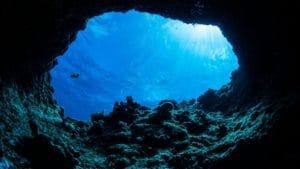
Dean’s Blue Hole, Bahamas
Blue holes can actually be found all around the world, but there’s a reason this part of the Bahamas is known as the Blue Hole capital of the world.
A blue hole is a massive sea cavern or sinkhole that is typically circular and can contain many submerged caverns.
Dean’s Blue Hole is the second deepest of its kind in the world, with a depth of 663 feet (202 meters).
It’s located near Clarence Town, Bahamas, and is host to a wide variety of colorful sea life, such as sea turtles, stingrays, and sharks.
Dean’s Blue Hole is an incredible place for divers new to cave diving.
This part of the world is known for excellent underwater visibility, and there are several locations or guided tours that cater to beginners.
If you’re doing any sort of Grand Bahama Island scuba diving, we highly suggest you check this location out.
Suggested Skill Level: All levels
Lanai Cathedrals, Hawaii
The Hawaiian island Lanai is home to two incredible underwater caves, known as Cathedral I and II.
Due to an unusual topography created by multiple volcanic eruptions, the Cathedrals have stunning views, vast rock and coral archways, coral reefs, and countless sea creatures.
The Lanai Cathedrals offer dives for all skill levels and can be an excellent opportunity for adding to your diving experience.
The Cathedrals can be dived year-round due to the area’s climate. The maximum depth here caps out at 65 feet (19 meters).
Suggested Skill Level: All levels
Cenotes, Mexico
There are dozens of cenotes located in Tulum, Mexico, in the Yucatan Peninsula.
Mexico’s famous cenotes are a vast network of sinkholes and underground passageways that slowly formed from thousands of years of erosion into limestone rock.
Some of these caves have roof cave-ins, which allow beams of sunlight to shine down on the freshwater beneath and creates swimming holes.
Cenotes tend to have many chambers connected by small tunnels, and people can only explore these via snorkeling and diving.
Many cenotes in Mexico welcome cave divers of all experience levels.
Some cenotes allow tourists to take guided snorkeling tours without certifications to show off the caverns’ natural beauty.
Suggested Skill Level: All levels
Indian Springs, Florida
The best place to cave dive in North America is located just south of Tallahassee, Florida.
Diving in Florida unlocks many different dive locations of varying categories.
Indian Springs is a large cavern that eventually funnels off into a cave.
The water inside the cave is clear and sometimes takes on a greenish tint, but it allows for high-visibility dives so divers can take in the cave’s beauty.
The maximum depth at Indian Springs is reported to be around 60 feet (17 meters).
Divers can choose to take the upstream or downstream paths through the cave system and visit several noteworthy chambers.
Suggested Skill Level: Some experience is recommended
Orda Cave, Russia
The Orda Cave, located in the Perm region of Russia, is the longest gypsum cave in the world at over 3 miles (5 kilometers).
Because gypsum dissolves quickly, the cave environment is constantly changing.
The Ordo cave has chambers as wide as 250 feet (76 meters) connected by tiny passageways.
Most of the Orda Cave has yet to be discovered, so the cave’s maximum depth is still unknown.
Divers will experience an ethereal underwater world here, lined with all-white walls, massive spaces, and miles to explore.
The cave has crystal clear mineral water, so divers experience incredible visibility in the chilly depths.
The climate in this part of Russia makes the conditions of the Orda Cave more complex than the other locations listed.
The chilly air, few surface stations, and a long trek down a rickety staircase are not for the faint of heart.
Suggested Skill Level: Experienced divers
Kilsby’s Sinkhole, Mt. Gambier, South Australia
The Kilsby’s Sinkhole is actually located on a bucolic sheep farm 14 kilometers south of Mt. Gambier.
It has a rich history for those interested in learning more about how world-famous diving sites came to be.
Many amateur divings frequented this sinkhole when it was first discovered in the 1950s, but the site closed down after several drownings.
It then became a weapons research center before being returned to the cave diving community.
The limestone sinkhole is 213 feet (65 meters) deep and filled with crystal clear water.
There are both overhead and non-overhead environments.
Suggested Skill Level: All levels
Where Will Your Cave Diving Take You?
Cave diving can be an enriching experience for divers who want to challenge themselves and visit parts of the Earth that few others have witnessed.
The training is rigorous, and the obstacles cave divers face are challenging, but learning to cave dive is a lifelong skill that can take you to incredible places.
